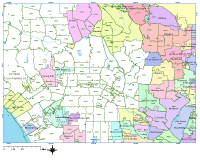Map Of The City Of Los Angeles Zip Code
- Posted in:Admin
- 21/04/18
- 54


Wxwidgets Serial Port Programming In Java there. • The, giant, historical symbol of Los Angeles. • (Macy Street) • • (original adobe jail) • • •, seat of the Asamblea when Los Angeles was the capital. •, courtroom/theatre was on the upper floor, market was on the ground floor, and clocktower was on top, with copper dome. Athanasius's, first Protestant church in Los Angeles, on Temple Road ('Salvation Alley'). Kearney's headquarters • 's house •, to Cahuenga Valley & the back way to San Fernando. • •, (Calle de las vides) • • on the Zanja Madre • Approximate run of the original, to current USC, through the former swamps of Leimert Park, and out to sea at Ballona Creek and Venice Beach. LP: ECR: Mexican rule ended during the: Americans took control from the after a series of battles, culminating with the signing of the on January 13, 1847.
California home prices displayed on an interactive Heat Map. See the most and least popular neighborhoods and ZIP codes, average/median home sales price in. Find your dream home on Trulia--Delightfully Smart Real Estate Search. This page shows a Google Map with an overlay of Zip Codes for Los Angeles County in the state of California. Users can easily view the boundaries of each Zip Code and.
With the completion of the line to Los Angeles in 1876. Oil was discovered in the city and surrounding area in 1892, and by 1923, the discoveries had helped California become the country's largest oil producer, accounting for about one-quarter of the world's petroleum output. By 1900, the population had grown to more than 102,000, putting pressure on the city's. The completion of the in 1913, under the supervision of, assured the continued growth of the city.
Due to clauses in the city's charter that effectively prevented the City of Los Angeles from selling or providing water from the aqueduct to any area outside its borders, many adjacent city and communities became compelled to annex themselves into Los Angeles. Los Angeles created the first municipal ordinance in the United States. On September 14, 1908, Los Angeles City Council promulgated residential and industrial land use zones. The new ordinance established three residential zones of a single type, where industrial uses were prohibited. The proscriptions included barns, lumber yards, and any industrial land use employing machine-powered equipment.
These laws were enforced against industrial properties after-the-fact. These prohibitions were in addition to existing activities which were already regulated as nuisances. These included explosives warehousing, gas works, oil-drilling, slaughterhouses, and.
Los Angeles City Council also designated seven industrial zones within the city. However, between 1908 and 1915, Los Angeles City Council created various exceptions to the broad proscriptions which applied to these three residential zones, and as a consequence, some industrial uses emerged within them.
There are two differences from the 1908 Residence District Ordinance and later zoning laws in the United States. First, the 1908 laws did not establish a comprehensive zoning map as the did.